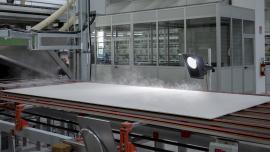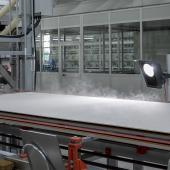Slowdown for Italian tile industry after record 2022
Italy’s tile industry hit record revenues of 7.2 billion euros in 2022 (up 16.5% on 2021), with sales volumes of 449 million sqm (down 1.4%). Momentum slows in first quarter of 2023, with 25% drop in export volumes.
Total revenues of 8.7 billion euros, representing a rise of 16% on 2021: this is the new record reached at the end of 2022 by the Italian ceramic industry as a whole, which comprises a total of 259 companies and 26,500 direct employees operating in the industry’s six different production sectors, namely tiles and large-format panels, sanitaryware, tableware, refractory materials, bricks and technical ceramic.
Such is the picture that emerges from the Confindustria Ceramica National Statistical Survey presented at the Annual Members’ Meeting on 14 June. It confirms, beyond question, the leading role played by the tile sector, which – with revenues of 7.2 billion euros – accounts for 83% of the industry’s total turnover.
The tile industry
As anticipated in forecasts drawn up last December, the results achieved by Italy’s 128 manufacturers of ceramic tiles and large-format panels in 2022 show that the volumes produced and sold remained broadly unchanged, while revenues rose significantly.
Production amounted to 431.2 million sq.m – the second highest volume since 2008 – down by just 0.9% from 435 million in 2021. Total sales – 449 million sq.m (down 1.4% on 2021) – are composed of sales on Italy’s domestic market (92.7 million sqm, up 1.7%), which is still riding the wave of a vigorous upturn in construction and renovation work, and exports, amounting to 356.2 million sqm (down 2.2% on the 2021 figure of 364 million), which are among the highest volumes recorded over the past 15 years.
The increase in list prices in response to sky-rocketing production costs (first and foremost energy) paved the way for Italian ceramic manufacturers to close 2022 with total revenues of 7.2 billion euros (up 16.5% on the 2021 figure of 6.2 billion). The 2022 figure comprises 1.2 billion euros from the domestic market (up 25.6%) and 6 billion from exports (up 14.8%), which is also a record high.
By the end of last year, the average selling price had risen from 10.6 euros per sqm to 12.43 euros per sqm on the domestic market, and from 14.3 euros per sqm to 16.76 euros per sqm on the export market (compared to about 10 euros and 8 euros for Spanish and Turkish manufacturers respectively).
The positive results deriving from the internationalisation of production also warrant attention: foreign companies operating in Europe and North America but controlled by Italian groups have generated revenues of over 1 billion euros.
Last but not least, investment continued to rise significantly in 2022 (up 25.6% in the wake of a 73% rise in 2021), to reach 441.3 million euros, or 6.1% of the industry’s total revenues.
Sluggish start to 2023
As forecast, the figures for the first quarter of 2023 have given a clear idea of the extent of the downturn in global demand, which had already made itself felt in the second half of the previous year.
Giovanni Savorani, Chairman of Confindustria Ceramica, gave his analysis of the figures, almost all of which had seen a double-digit decline: compared to the first quarter of 2022, exports of Italian tiles fell by 25% by volume and 13% by value, across all markets; the volumes sold in Italy also fell by about 10%, while rising in value by a few percentage points.
“After the incredible performance of the first six months of 2022,” Giovanni Savorani points out, “there can be no doubt that a return to lower values was predictable, even though the reason for the downturn lies mainly in the profound change in the global scenario, marked by sharply rising interest rates, stubbornly high inflation, the end of the post-lockdown spending spree and a dip in consumer confidence. Against this backdrop, international competition is becoming fiercer, and the Italian and European industry are paying close attention to ensure that all exporters, including those in India and China, apply the rules of fair trade.”
The Chairman of Confindustria Ceramica confirmed that the drop in electricity and thermal energy prices was a boon for the sector, adding however that
“All the structural problems are still unresolved, such as the absence of implementing decrees to increase national gas extraction by 2 billion cubic metres for the benefit of gas-hungry industries, and a reform of the ETS that is set to increase the competitive penalties faced by EU industry.”
For ceramic manufacturers, the ETS, which was formulated for the laudable purpose of facilitating decarbonisation, has proved ineffective and counter-productive in terms of environmental benefits, and actually had a regressive effect on the industry.
“Current CO2 prices,” points out Savorani, are hovering around 85 euros per tonne, up from 25 euros as recently as June 2019. Even the ‘Fit for 55’ plan, aimed at structurally reducing emissions, adversely affects the competitiveness of our sector, because our production facilities have already achieved all the possible efficiency gains, and alternative technological solutions are not currently feasible.”
In this regard, Savorani confirms that testing on the electrification of production processes is already under way, but operating costs are still very high, in the same way that producing H2 is still unaffordable in terms of the electricity it requires.
Savorani believes that performance over the year as a whole is still difficult to forecast, but remains confident that things could turn around in the second half of 2023, coinciding with the upcoming 40th edition of Cersaie in Bologna.
On the cover: Marazzi, Naturalia
Did you find this article useful?
Join the CWW community to receive the most important news from the global ceramic industry every two weeks























